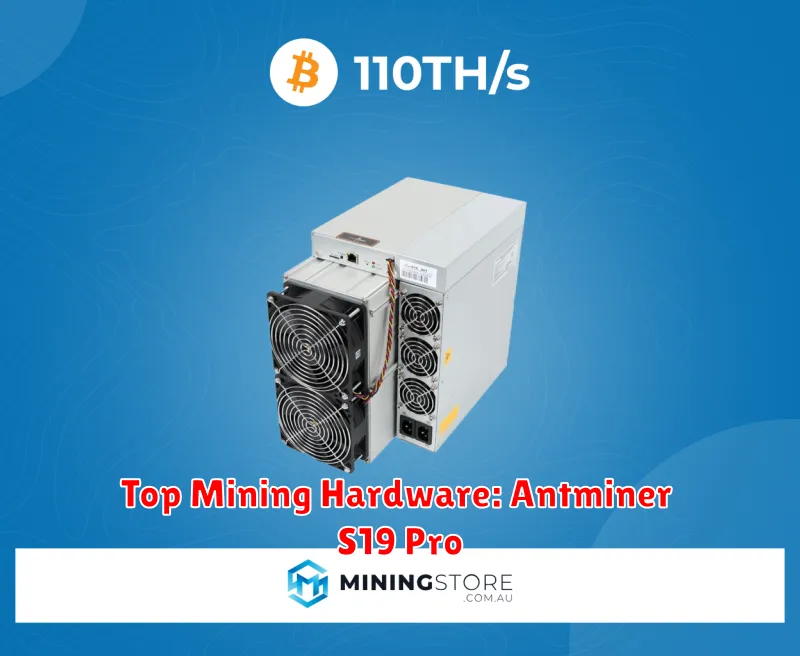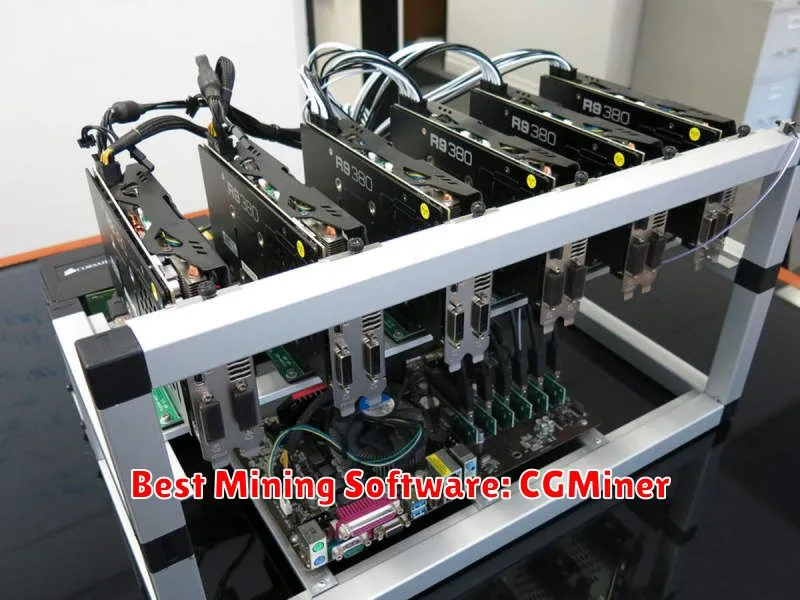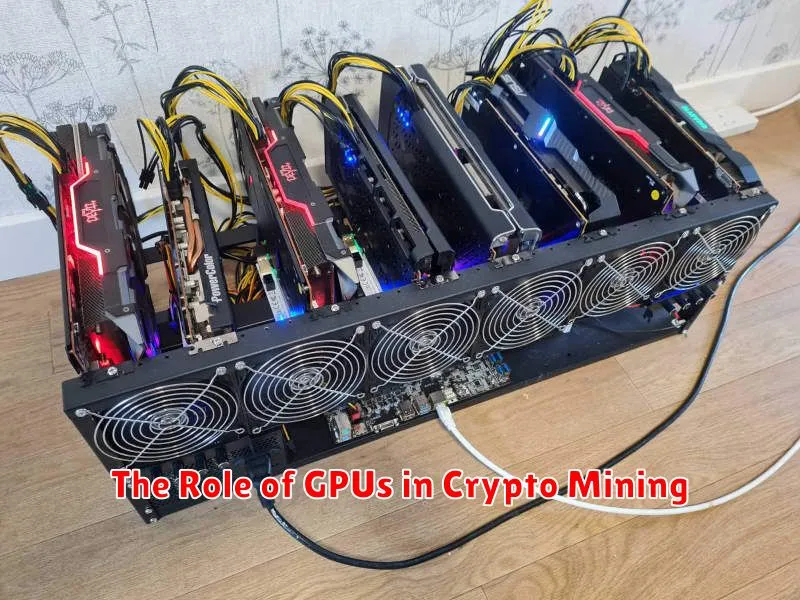Ready to dive into the exciting world of crypto mining? This guide to the top crypto mining tools for beginners will equip you with the knowledge and resources you need to get started. We’ll explore the best mining software, essential hardware recommendations, and helpful tips and tricks to maximize your cryptocurrency mining profitability. Whether you’re interested in mining Bitcoin, Ethereum, or other popular altcoins, this comprehensive resource will help you navigate the complexities of crypto mining and start earning rewards efficiently and effectively.
What is Crypto Mining?
Crypto mining is the process of verifying and adding new transactions to a blockchain. It involves solving complex mathematical problems using powerful computers. The first miner to solve the problem gets to add the next block of transactions to the chain and is rewarded with newly created cryptocurrency.
Think of it like this: miners are essentially maintaining the security and integrity of the cryptocurrency network. Their computational power ensures that transactions are recorded accurately and prevents fraudulent activity. The reward system incentivizes participation and ensures the network remains decentralized.
Different cryptocurrencies use different mining algorithms, and some require specialized hardware, like ASICs (Application-Specific Integrated Circuits), while others can be mined with GPUs (Graphics Processing Units) or even CPUs (Central Processing Units). The difficulty of mining also varies depending on the cryptocurrency and the total network hash rate (the combined computing power of all miners).
Mining can be profitable, but it requires a significant upfront investment in hardware and electricity, and success depends on several factors, including the price of the cryptocurrency being mined and the competition from other miners.
Top Mining Hardware: Antminer S19 Pro

For beginners venturing into cryptocurrency mining, choosing the right hardware is crucial. The Antminer S19 Pro stands out as a popular and powerful option.
This ASIC miner is known for its high hash rate, meaning it can solve complex cryptographic problems faster, leading to a higher chance of mining a block and earning cryptocurrency rewards. Its relatively low power consumption compared to its hashing power makes it energy-efficient, minimizing operational costs.
While the Antminer S19 Pro is a powerful and efficient miner, it’s important to note that the initial investment cost is significant. Additionally, profitability depends on various factors like cryptocurrency price fluctuations, network difficulty, and electricity costs. Thorough research and understanding of these factors are essential before purchasing any mining hardware.
Ease of use is another factor to consider. While the Antminer S19 Pro isn’t necessarily the simplest miner to set up, ample online resources and support communities are available to guide beginners through the process.
Ultimately, the Antminer S19 Pro represents a strong contender in the world of Bitcoin mining hardware, offering a balance of performance and efficiency, making it a viable option for those serious about cryptocurrency mining, but always remember to carefully consider the costs and potential risks involved.
Best Mining Software: CGMiner

For beginners venturing into cryptocurrency mining, choosing the right software is crucial. CGMiner stands out as a popular and relatively user-friendly option, especially for those new to the process. Its strength lies in its simplicity and effectiveness.
CGMiner is a command-line interface (CLI) program, meaning it’s text-based. While this might seem daunting at first, many find the direct control and detailed information provided by the CLI beneficial. Numerous tutorials and guides are available online to help newcomers navigate the interface and get started quickly.
One of CGMiner’s key advantages is its broad support for various mining algorithms and hardware. This versatility allows miners to experiment with different cryptocurrencies and adapt to changing market conditions. Its open-source nature also contributes to a strong community providing support and ongoing development.
However, CGMiner does require a degree of technical understanding. While beginner-friendly compared to some alternatives, familiarity with basic command-line operations is helpful. Users should be comfortable with text-based instructions and troubleshooting minor issues that may arise.
In summary, CGMiner offers a good balance of power and accessibility for beginning miners. Its versatility, wide hardware support, and active community make it a solid choice for those wanting to explore the world of cryptocurrency mining.
Cloud Mining Options for Beginners
Cloud mining offers a beginner-friendly entry point into cryptocurrency mining without the complexities of managing hardware. Instead of buying and maintaining your own mining rigs, you rent computing power from a cloud mining provider. This eliminates the need for technical expertise in hardware setup, cooling, and maintenance.
Choosing a reputable provider is crucial. Look for companies with a proven track record, transparent fee structures, and positive user reviews. Be wary of scams promising unrealistic returns. Research thoroughly before committing any funds.
Popular cloud mining platforms often offer contracts of varying lengths and hashing power. Consider your budget and risk tolerance when selecting a contract. Smaller contracts allow for experimentation with lower initial investment.
Understanding contract terms is paramount. Pay close attention to the contract’s duration, the hashrate you’re renting, the mining fees, and any potential maintenance or withdrawal fees. Many contracts offer daily or weekly payouts, which can be tracked online.
Security should be a primary concern. Choose providers with robust security measures to protect your investment and prevent unauthorized access. Always use strong passwords and enable two-factor authentication where available.
While cloud mining simplifies the process, profitability isn’t guaranteed. Cryptocurrency prices fluctuate, and mining difficulty increases over time. Thorough research and realistic expectations are key to a successful cloud mining experience.
Calculating Mining Profitability

Before you start mining cryptocurrency, it’s crucial to understand profitability. This involves carefully calculating your potential earnings against your expenses.
Key factors to consider include:
- Cryptocurrency price: The current market value of the cryptocurrency you’re mining directly impacts your profits.
- Mining difficulty: As more miners join the network, the difficulty increases, requiring more computational power and energy to mine a block, reducing your potential rewards.
- Hashrate: Your mining rig’s hashrate (computing power) determines how quickly you solve complex mathematical problems and earn rewards. A higher hashrate means potentially more rewards.
- Electricity costs: Mining consumes significant energy. Calculate your electricity consumption and cost per kilowatt-hour (kWh) to determine energy expenses.
- Hardware costs: Include the initial investment in mining hardware (ASICs or GPUs), as well as maintenance and potential repairs.
- Mining pool fees: If you join a mining pool, factor in the fees they charge for distributing rewards.
Profitability calculation: A simplified formula is:
(Daily cryptocurrency rewards x Cryptocurrency price) – (Daily electricity costs + other daily costs) = Daily profit
Important Note: This is a simplified calculation. Fluctuations in cryptocurrency prices and mining difficulty significantly impact profitability. Use online mining profitability calculators to get a more accurate estimate, inputting your specific hardware, electricity costs, and chosen cryptocurrency.
Thoroughly analyze the potential profitability before investing in cryptocurrency mining equipment. A negative profit margin means you’re losing money.
The Role of GPUs in Crypto Mining

Graphics Processing Units (GPUs) have become a cornerstone of cryptocurrency mining, particularly for algorithms that aren’t optimized for ASICs (Application-Specific Integrated Circuits).
Unlike CPUs (Central Processing Units), which are designed for general-purpose computing, GPUs excel at parallel processing. This makes them incredibly efficient at solving the complex mathematical problems inherent in many cryptocurrency mining algorithms, such as those used by Ethereum (before the merge) and several other altcoins.
The parallel processing power of GPUs allows them to perform numerous calculations simultaneously, significantly speeding up the mining process. This translates to a higher chance of successfully mining a block and earning cryptocurrency rewards.
However, it’s important to note that the profitability of GPU mining fluctuates significantly based on factors like cryptocurrency prices, network difficulty, and electricity costs. Furthermore, the high power consumption of GPUs needs to be considered.
For beginners, understanding the role of GPUs is crucial for selecting the right mining hardware. While ASICs may be more powerful for specific coins, GPUs offer a more versatile and accessible entry point to the world of cryptocurrency mining.
Energy Efficiency Tips for Miners
Cryptocurrency mining can be energy-intensive. To minimize your environmental impact and electricity bills, consider these tips:
Choose efficient hardware: Invest in ASIC miners designed for your chosen cryptocurrency. Newer models generally offer better hashrates per watt.
Optimize your mining software: Configure your mining software to maximize efficiency. This often involves adjusting settings like overclocking (carefully!), fan speeds, and power limits. Don’t push your hardware too hard, as this can lead to reduced lifespan and higher energy consumption.
Monitor your power consumption: Use monitoring tools to track your miner’s energy usage. This allows you to identify inefficiencies and optimize your setup. Regularly check your power draw to ensure it remains within acceptable levels.
Improve cooling: Proper cooling is crucial. Overheating leads to increased energy consumption and potential hardware damage. Invest in adequate ventilation and consider using cooling solutions like fans or liquid cooling systems.
Consider renewable energy sources: If possible, power your mining operation with renewable energy sources like solar or wind power to reduce your carbon footprint significantly.
Join a mining pool: Mining pools distribute the workload and increase the chances of finding a block, potentially reducing the overall energy needed per coin mined.
By following these tips, you can significantly reduce your energy costs and contribute to a more sustainable cryptocurrency mining practice.
How to Join a Mining Pool
Joining a mining pool significantly increases your chances of successfully mining cryptocurrency. Instead of competing solo against potentially thousands of other miners, you pool your computing power with others, sharing the rewards proportionally to your contribution.
The process generally involves these steps:
- Choose a Mining Pool: Research different pools and compare their fees, payout methods (e.g., PPS, PPLNS), and server locations. Consider factors like pool size (larger pools offer more consistent payouts but may have higher fees) and their reputation for transparency and reliability.
- Create an Account: Most pools require you to create an account. You’ll need a valid email address and likely a cryptocurrency wallet address where your earnings will be sent.
- Configure Your Mining Software: Your mining software (like CGMiner or others) needs to be configured to connect to your chosen pool. This usually involves entering the pool’s server address, your worker name (a unique identifier), and your account details.
- Start Mining: Once configured correctly, start your mining software. You should see your hash rate being reported to the pool, indicating that your mining power is contributing to the collective effort.
- Monitor Your Earnings: Regularly check your account on the pool’s website to monitor your mining progress and accumulated rewards. Payouts usually occur once you reach a certain threshold.
Remember to always research thoroughly and choose a reputable mining pool to avoid scams. Security is also paramount; ensure your mining software and wallet are properly secured.
The Future of Crypto Mining
The future of crypto mining is complex and multifaceted, influenced by several key factors. Sustainability is paramount. As environmental concerns grow, miners are increasingly adopting renewable energy sources and exploring more energy-efficient mining techniques. This shift is crucial for the long-term viability of the industry.
Regulation plays a significant role. Governments worldwide are grappling with how to regulate crypto mining, impacting its accessibility and profitability. Some jurisdictions are becoming more welcoming, while others are imposing stricter rules, leading to uncertainty for miners.
Technological advancements continue to shape the landscape. The development of more efficient mining hardware and algorithms will influence the profitability and competitiveness of various mining operations. ASIC resistance and the rise of Proof-of-Stake (PoS) consensus mechanisms may also reduce the reliance on energy-intensive Proof-of-Work (PoW) mining.
Ultimately, the future of crypto mining depends on a delicate balance between profitability, technological innovation, and regulatory acceptance. While challenges remain, the industry’s adaptability and its commitment to sustainability suggest a future where crypto mining evolves to become more environmentally friendly and economically viable.

